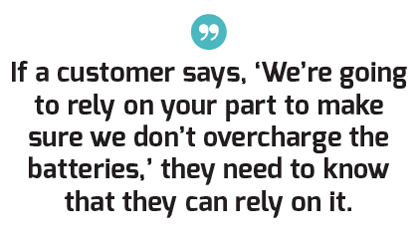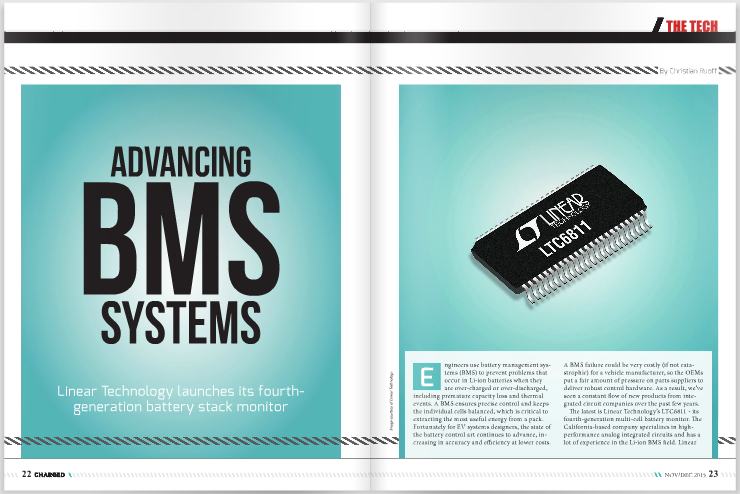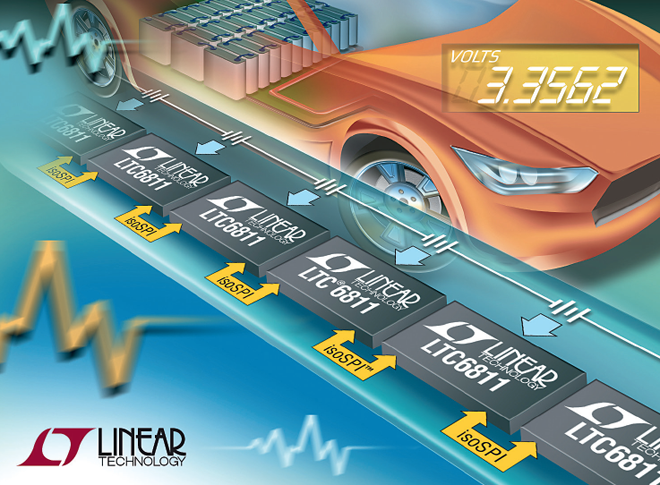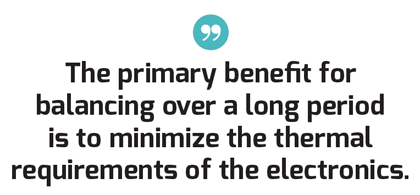Engineers use battery management systems (BMS) to prevent problems that occur in Li-ion batteries when they are over-charged or over-discharged, including premature capacity loss and thermal events. A BMS ensures precise control and keeps the individual cells balanced, which is critical to extracting the most useful energy from a pack. Fortunately for EV systems designers, the state of the battery control art continues to advance, increasing in accuracy and efficiency at lower costs.
A BMS failure could be very costly (if not catastrophic) for a vehicle manufacturer, so the OEMs put a fair amount of pressure on parts suppliers to deliver robust control hardware. As a result, we’ve seen a constant flow of new products from integrated circuit companies over the past few years.
The latest is Linear Technology’s LTC6811 – its fourth-generation multi-cell battery monitor. The California-based company specializes in high-performance analog integrated circuits and has a lot of experience in the Li-ion BMS field. Linear Technology’s third-gen battery monitor chip (part number LTC6804) is a popular part, used by high-volume EV makers in many well-known plug-in models. Also among Linear’s family of high-voltage battery ICs is what it calls a “high efficiency bidirectional multi-cell active balancer” (part number LTC3300) – which Charged discussed in detail back in Issue 7.
Chip history
Linear’s first-generation chip, intended for precision battery management in hybrid/electric vehicles, was released in 2008. The LTC6802 was a multi-cell battery stack monitor that can measure up to 12 Li-ion cells. Many LTC6802 ICs could be connected in series to enable the simultaneous monitoring of every cell of a long, high-voltage battery string. In 2010, the company released the LTC6803, adding many incremental feature improvements, including advanced noise filtering. Then in 2013, Linear launched a totally new architecture with the LTC6804, with a focus on improving accuracy and noise immunity.
Because the LTC6804 is a popular part, used in production vehicles and slated for several new programs, Linear decided the fourth generation needed to be a drop-in replacement (meaning the LTC6811 is pin compatible and software compatible to the previous generation). “It takes a very long time to design new parts into systems,” Greg Zimmer, Senior Product Marketing Engineer at Linear, told Charged. “Our customers have invested a lot of effort into their LTC6804 designs, so it’s critical that they can drop this part in while improving and adding new features.

Failure is not an option
Like all the products in this family, the LTC6811 is designed for the automotive environment. As just one example, the LTC6811 includes a dedicated deep buried Zener reference to avoid measurement error that often creeps into a circuit after mechanical stress from PCB assembly, thermal variations, humidity, or just plain aging. The buried Zener reference has well-established long-term stability and accuracy. The new LTC6811 battery monitor features extensive fault coverage to ensure that costly problems don’t occur – including a redundant voltage reference, logic test circuitry, cross-channel testing, open wire detection capability, a watchdog timer and packet error checking on the serial interface.
“If a customer says, ‘We’re going to rely on your part to make sure we don’t overcharge the batteries,’ they need to know that they can rely on it,” said Zimmer. “So we have a lot of self-test features, cross-checking and redundancy to show that if a problem occurs, this is how it would be handled. Our previous generation battery monitors had redundancy and cross-checking, but we have continuously improved and refined these features. We’re always looking to see how the system designer can build their BMS and have confidence that our part is up to the challenge.”
Balancing act
Designers are keenly interested in ensuring consistent state of charge (SOC) among the individual battery cells, since this will increase the useful life of the battery pack. The problem is that a stack of cells in series is ultimately limited by the weakest cell. Because they’re all in series, they all receive the same charge and load current. During charging, if one cell reaches its upper limit first, you have to stop charging the whole stack – even though the other cells could hold more energy – because issues can occur when lithium-ion cells are overcharged. Likewise, when you’re discharging, the weakest cell will reach its “can’t-go-any-lower” point (or it will lose capacity), and discharging stops, even though the other cells have additional useful energy. So, maintaining an equal SOC throughout the stack is highly beneficial in both directions.
To keep the cells on par with one another, engineers employ battery balancing systems of two basic types: passive and active.
During the charge process, not all cells in a stack may reach full charge at the same time. One reason that this can happen is due to differences in capacity between cells. The smaller capacity (“weaker”) cells will reach a fully charged state first. In a passive system, when a cell reaches its maximum SOC before the other cells in the stack, the battery balancer can discharge them by switching in a resistive element across the cell. This effectively loses the energy that would be forced into this weaker cell, but allows the other cells to continue accepting more energy during a charging event.
In an active system, energy is shuttled from the weaker cells to the stronger cells. This creates a more energy-efficient battery pack, but it requires a more complex and robust topology.
Linear’s new LTC6811 acts as the hub for controlling active and passive balancing and boasts new control features for both techniques. The chip includes internal passive balancing FETs that can discharge individual cells, or directly control higher-power external FETs. One new control feature is the ability to discharge cells while in a low-power state, such as when the battery pack is at rest. “Passive discharging is only useful during the charge cycle,” explained Zimmer. “However, vehicles are typically charged when the car is parked and the systems are at rest. During this state, designers would like the BMS processor to be powered down. With passive balancing timers, the processor can initiate passive balancing for each cell, up to two hours, and enter a low-power standby mode.”
“The primary benefit for balancing over a long period is to minimize the thermal requirements of the electronics. By increasing the balancing time, the balancing current can be reduced. The internal FETs in the LTC6811 can handle 50 mA of current for passive balancing to dissipate energy across a resistor. Larger discharge current requires external FETs – the more current, the larger and more expensive the FETs. Also, discharging generates heat – the more heat, the more complex and expensive the thermal design (such as adding heat sinking).”
For active balancing controls, the LTC6811’s balancing pins can be operated as a serial interface to control Linear’s LT8584 active balance circuit. The LT8584 is a monolithic flyback DC/DC converter that allows for greater than 99% capacity recovery in stacks of mismatched cells. The LT8584 supports uni-directional operation, allowing for charge to be transferred from each individual cell to the top of the stack. The LTC6811 can also interface to Linear’s SPI-based active balancing IC – the LTC3300 – a fault-protected controller IC for bidirectional active balancing. Like the LT8584, the LTC3300 can transfer charge from each individual cell to the stack, but it can also transfer from the stack to each individual cell. In this way, the LTC3300 can directly compensate for a cell that is reaching its low SOC limit.

Passive vs active balancing in production vehicles
Most, if not all, production vehicles employ a passive balancing technique because of the OEMs’ sensitivity to costs. “Active balancing is not used in any production vehicle that I’m aware of,” said Zimmer. “Everyone is exploring and testing it, but it’s a lot cheaper to go with passive. Efficient active balancing requires transformers, and bi-directional operation requires additional transformers. All of this can be a few dollars per channel multiplied by dozens, or hundreds, of channels depending on how many cells are in the system.”
So where is active balancing used today? Zimmer explains that it works great for battery pack applications that have challenges dissipating the thermal loads generated by passive balancing. Passive systems turn excess energy into heat, whereas active systems attempt to save as much useful energy as possible. Also, active balancing is used for applications that need the highest possible energy density. “It could become more mainstream in production vehicles,” explained

The specs
The LTC6811 incorporates an ultra-stable voltage reference, high-voltage multiplexers, 16-bit delta-sigma ADCs, and a 1 Mbps isolated serial interface. It can measure up to 12 series-connected battery cells with better than 0.04% accuracy. Linear says it provides “outstanding noise reduction” with 8 programmable 3rd-order low-pass filter settings, and cell measurements within 290 μsec in the fastest ADC mode.
Multiple chips can be interconnected and operated simultaneously, using Linear’s proprietary 2-wire isoSPI interface. Integrated into every LTC6811, the isoSPI interface provides high RF noise immunity up to 1 Mbps and up to 100 meters of cable, using only twisted pair. Two communication options are available: with the LTC6811-1, multiple devices are connected in a daisy chain with one host processor connection for all devices; with the LTC6811-2, multiple devices are connected in parallel to the host processor and each device is individually addressed.
The LTC6811 is fully specified for operation from -40° to 125° C, and has been designed for ISO 26262 (ASIL) compliant systems. It is designed to operate at the most critical location in the battery system, directly connected to the battery cells. In this position, between the BMS microprocessor and peripheral devices, the LTC6811 can monitor battery sensors such as current or temperature, and closely correlate these values to cell measurements.

Controlling the future
For whatever reason, battery control electronics do not receive nearly as much media attention as new developments in cell chemistry. However, it’s hard to overstate the critical role the BMS has played in the long-term success of EVs. Continually creating better electronics translates into maximizing operating range, lifetime, safety and reliability, while minimizing cost, size and weight. Linear’s fourth-generation battery stack monitor is the latest example of clear progress: more performance, features and efficiency at a lower cost.
This article originally appeared in Charged Issue 22 – November/December 2015. Subscribe now.






















































